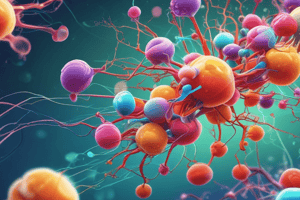Podcast
Questions and Answers
What are the main components of carbohydrates and give two examples?
What are the main components of carbohydrates and give two examples?
Carbohydrates are composed of carbon, hydrogen, and oxygen. Examples include glucose and starch.
Describe the role of proteins in living organisms.
Describe the role of proteins in living organisms.
Proteins play various roles such as catalyzing reactions, providing structural support, and transporting molecules. They also participate in immune responses.
What is dehydration synthesis and how does it occur in the formation of proteins?
What is dehydration synthesis and how does it occur in the formation of proteins?
Dehydration synthesis is a chemical reaction that covalently bonds two molecules while losing a water molecule. In proteins, it occurs by linking amino acids through peptide bonds.
How does hydrolysis contribute to the digestion of macromolecules?
How does hydrolysis contribute to the digestion of macromolecules?
What is the significance of biosynthesis pathways in cellular functions?
What is the significance of biosynthesis pathways in cellular functions?
Explain the role of lipids in biological systems.
Explain the role of lipids in biological systems.
What is the overall importance of carbohydrates in living organisms?
What is the overall importance of carbohydrates in living organisms?
Flashcards are hidden until you start studying
Study Notes
Types of Macromolecules
-
Carbohydrates
- Composed of carbon, hydrogen, and oxygen.
- Monosaccharides (simple sugars), disaccharides (two sugars), polysaccharides (many sugars).
- Examples: glucose, sucrose, starch, cellulose.
-
Proteins
- Made of amino acids linked by peptide bonds.
- Functions include catalyzing reactions (enzymes), structural roles, transport, and immune response.
- Examples: hemoglobin, antibodies, enzymes.
-
Lipids
- Hydrophobic molecules including fats, oils, and steroids.
- Functions in energy storage, structure (membranes), and signaling.
- Examples: triglycerides, phospholipids, cholesterol.
-
Nucleic Acids
- Polymers made of nucleotide monomers (sugar, phosphate group, nitrogenous base).
- Two types: DNA (genetic information) and RNA (protein synthesis).
- Examples: DNA, RNA, ATP.
Functions of Macromolecules
- Carbohydrates: Energy source, structural components, cell recognition.
- Proteins: Enzymatic activity, structural support, transport, signaling, immune defense.
- Lipids: Long-term energy storage, membrane formation, hormone precursors.
- Nucleic Acids: Storage and transmission of genetic information, protein synthesis.
Dehydration Synthesis Process
- Definition: A chemical reaction in which two molecules are covalently bonded with the loss of a water molecule.
- Importance: Synthesizes macromolecules:
- Carbohydrates: Forming glycosidic bonds between monosaccharides.
- Proteins: Linking amino acids through peptide bonds.
- Nucleic Acids: Connecting nucleotides into polynucleotide chains.
Hydrolysis Reactions
- Definition: A chemical breakdown of a compound due to reaction with water.
- Importance: Digests macromolecules into monomers:
- Carbohydrates: Breaking glycosidic bonds.
- Proteins: Cleaving peptide bonds.
- Nucleic Acids: Separating nucleotides from polynucleotide chains.
Biosynthesis Pathways
- Definition: Series of enzyme-catalyzed reactions that produce complex biomolecules from simpler precursors.
- Examples:
- Glycolysis: Breakdown of glucose to pyruvate, producing energy.
- Citric Acid Cycle: Central metabolic pathway for aerobic respiration.
- Fatty Acid Synthesis: Formation of fatty acids for lipid production.
- Importance: Essential for growth, development, and cellular functions in living organisms.
Macromolecules
- Carbohydrates are composed of carbon, hydrogen, and oxygen.
- Monosaccharides are simple sugars, like glucose.
- Disaccharides contain two sugars, like sucrose.
- Polysaccharides are complex sugars, like starch and cellulose.
- Proteins are made of amino acids linked by peptide bonds.
- Proteins have various functions including catalyzing reactions as enzymes, providing structural support, aiding in transport, and participating in immune response.
- Examples include hemoglobin, antibodies, and enzymes.
- Lipids are hydrophobic molecules.
- Lipids include fats, oils, and steroids.
- Function in energy storage, structure (membranes), and signaling.
- Examples include triglycerides, phospholipids, and cholesterol.
- Nucleic Acids are polymers made of nucleotide monomers.
- Nucleotides consist of a sugar, phosphate group, and nitrogenous base.
- Two types: DNA stores genetic information, and RNA is involved in protein synthesis.
- Examples include DNA, RNA, and ATP.
Functions of Macromolecules
- Carbohydrates serve as an energy source, provide structural components, and participate in cell recognition.
- Proteins play crucial roles in enzymatic activity, structural support, transport, signaling, and immune defense.
- Lipids are important for long-term energy storage, membrane formation, and hormone production.
- Nucleic Acids are essential for storing and transmitting genetic information, and protein synthesis.
Dehydration Synthesis
- A chemical reaction where two molecules are covalently bonded with the loss of a water molecule.
- Used for the synthesis of macromolecules:
- Carbohydrates: Forming glycosidic bonds between monosaccharides.
- Proteins: Linking amino acids through peptide bonds.
- Nucleic Acids: Connecting nucleotides into polynucleotide chains.
Hydrolysis Reactions
- A chemical breakdown of a compound due to reaction with water.
- Digests macromolecules into monomers:
- Carbohydrates: Breaking glycosidic bonds.
- Proteins: Cleaving peptide bonds.
- Nucleic Acids: Separating nucleotides from polynucleotide chains.
Biosynthesis Pathways
- Series of enzyme-catalyzed reactions that produce complex biomolecules from simpler precursors.
- Examples:
- Glycolysis breaks down glucose to pyruvate, producing energy.
- Citric Acid Cycle is a central metabolic pathway for aerobic respiration.
- Fatty Acid Synthesis produces fatty acids for lipid production.
- Examples:
- Importance: Biosynthesis pathways are essential for growth, development, and cellular functions in living organisms.
Studying That Suits You
Use AI to generate personalized quizzes and flashcards to suit your learning preferences.



